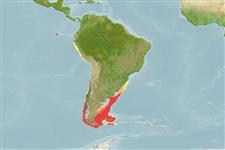Common names from other countries
Environment: milieu / climate zone / depth range / distribution range
Écologie
; profondeur 0 - 228 m (Ref. 87801). Temperate
Distribution
Pays | Zones FAO | Écosystèmes | Occurrences | Introductions
Southern Ocean.
Length at first maturity / Taille / Poids / Âge
Maturity: Lm ? range ? - ? cm
It burrows in mud and sand in the intertidal to a depth of 228 m (Ref. 87801).
Life cycle and mating behavior
Maturité | Reproduction | Frai | Œufs | Fécondité | Larves
Members of the class Holothuroidea are gonochoric and have only one gonad. Spawning and fertilization are both external and some exhibit brooding. Life cycle: Embryos develop into planktotrophic larvae (auricularia) then into doliolaria (barrel-shaped stage) which later metamorphose into juvenile sea cucumbers.
Häussermann, V. and G. Försterra. 2009. (Ref. 87801)
Statut dans la liste rouge de l'IUCN (Ref. 130435)
statut CITES (Ref. 108899)
Not Evaluated
Not Evaluated
Menace pour l'homme
Harmless
Utilisations par l'homme
| FishSource |
Outils
Plus d'informations
Taille/ÂgeCroissanceLongueur-poidsLongueur-longueurMorphologieLarvesAbondance
Sources Internet
Estimates based on models
Preferred temperature
(Ref.
115969): 5.5 - 14.6, mean 7.6 (based on 313 cells).
